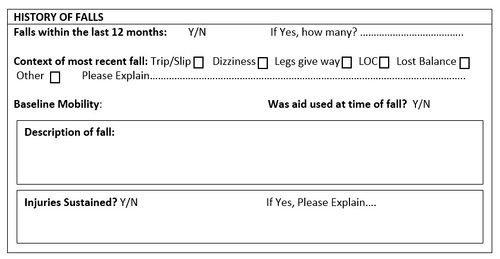5 Simple Techniques For Dementia Fall Risk
Dementia Fall Risk - Truths
Table of Contents4 Easy Facts About Dementia Fall Risk DescribedSome Ideas on Dementia Fall Risk You Should KnowDementia Fall Risk - The FactsThe Only Guide for Dementia Fall Risk5 Simple Techniques For Dementia Fall Risk
In the neighborhood, inadequate street illumination or unprotected creeks and landfills may additionally cause crashes. Loss Threat Assessment Device (FRAT) is a 4-item falls-risk screening device for sub-acute and household care. The FRAT has 3 areas: fall risk condition, threat element checklist, and activity strategy. A Loss Danger Standing consists of information about background of current drops, drugs, psychological and cognitive condition of the person.If the individual ratings on a risk aspect, the matching variety of points are counted to the client's loss threat rating in package to the far best. If a client's autumn danger score amounts to five or greater, the individual is at high danger for falls. If the patient scores just 4 factors or reduced, they are still at some risk of dropping, and the registered nurse needs to utilize their best clinical assessment to manage all fall threat factors as part of an all natural treatment strategy.
These common techniques, as a whole, aid create a risk-free environment that reduces unintentional drops and delineates core preventative procedures for all clients. Signs are important for clients in jeopardy for falls. Health care suppliers need to recognize that has the condition, for they are accountable for carrying out activities to advertise person security and prevent drops.
6 Easy Facts About Dementia Fall Risk Shown
Wristbands need to include the individual's last and initial name, day of birth, and NHS number in the UK. Information need to be printed/written in black against a white background. Only red color must be used to signify unique person status. These suggestions are regular with present advancements in client recognition (Sevdalis et al., 2009).
Things that are also much may require the individual to get to out or ambulate unnecessarily and can potentially be a hazard or add to falls. Aids prevent the person from heading out of bed with no aid. Registered nurses react to fallers' phone call lights faster than they do to lights started by non-fallers.
Aesthetic impairment can significantly cause drops. Hip pads, when put on effectively, might decrease a hip fracture when fall takes place. Keeping the beds closer to the floor minimizes the threat of falls and significant injury. Placing the cushion on the floor significantly reduces autumn risk in some healthcare setups. Reduced beds are developed to reduce the distance an individual drops after moving out of bed.
How Dementia Fall Risk can Save You Time, Stress, and Money.
Patients who are tall and with weak leg muscle mass that attempt to rest on the bed from a standing position are most likely to drop onto the bed because it's too low for them to lower themselves safely. Also, if a high patient efforts to stand up from a reduced bed without help, the person is likely to fall back down onto the bed or miss the bed and fall onto the flooring.
They're created to advertise prompt rescue, not to stop drops from bed. Apart from bed alarm systems, raised guidance for risky people likewise may help protect against drops.

Clients with an evasion stride rise fall possibilities considerably. To reduce fall threat, footwear must be with a little to no heel, slim soles with slip-resistant step, and support the ankle you could try this out joints. Recommend client to use nonskid socks to avoid the feet from moving upon standing. However, encourage clients to use ideal, well-fitting shoesnot nonskid socks for ambulation.
Dementia Fall Risk for Beginners
Clients, specifically older grownups, have lowered aesthetic ability. Illumination an unfamiliar environment helps boost exposure if the individual have to get up in the evening. In a study, homes with ample lighting record fewer drops (Ramulu et al., 2021). Renovation in illumination in the house may reduce loss rates in older grownups (Dementia Fall Risk). Using gait see page belts by all health treatment companies can promote safety and security when assisting patients with transfers from bed to chair.

Caretakers work for guaranteeing a safe and secure, protected, and secure atmosphere. Researches showed really low-certainty proof that caretakers minimize loss risk in intense treatment health centers and only moderate-certainty that options like video clip tracking can lower sitter usage without increasing fall danger, recommending that caretakers are not as helpful as originally believed look at these guys (Greely et al., 2020).
Dementia Fall Risk - An Overview

Enhanced physical fitness decreases the danger for falls and restricts injury that is endured when fall transpires. Land and water-based workout programs may be similarly useful on balance and stride and thereby lower the risk for falls. Water exercise may add a positive advantage on balance and stride for ladies 65 years and older.
Chair Rise Exercise is an easy sit-to-stand exercise that aids enhance the muscular tissues in the upper legs and butts and boosts movement and independence. The goal is to do Chair Increase workouts without utilizing hands as the customer becomes more powerful. See resources section for a detailed guideline on just how to do Chair Increase workout.